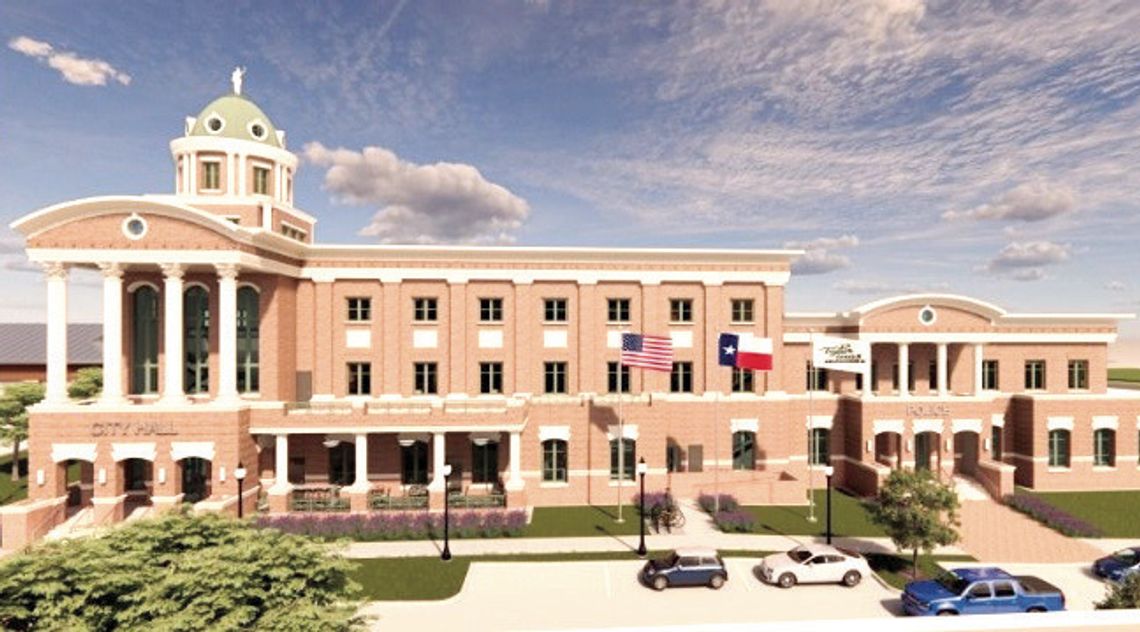While Texas is known for its historic and often charming courthouses and city halls, Hutto and Taylor officials say some of their government buildings are well past their prime and need to be replaced.
Taylor is now considering a proposed $53 million complex that would house major municipal offices all at one site.
Hutto wants a new Police Department building.
Proponents of the Taylor project note current municipal facilities occupy a patchwork of older buildings scattered around downtown: A former Safeway grocery store houses City Hall at 400 N. Porter St., an old bank branch serves as the Municipal Court at 109 W. Fifth St. and a vacated beer distribution facility is home to the police force, 500 S. Main St.
“Both the police station and Municipal Courthouse have outlived their intended lifespans,” Mayor Dwayne Ariola said. “For both operational efficiency and safety, we need to upgrade these facilities.”
Supporters want the new Justice Center — which is also a City Hall — to be the beating heart of Taylor, home to art installations and the site of fairs and festivals, they said.
Hutto staffers said they face similar issues with outdated buildings, including the Police Department. Funding for that initiative, however, is not as far along as Taylor’s.
FORMER GRANDEUR IN TAYLOR
Taylor once had a stately City Hall similar to other small Texas towns.
A public building with a domed cupola and pillars at the front once stood on Main Street where Heritage Square Park now sits. Built in 1914, the crowning glory of the small town was deemed unsafe in 1983 and was demolished in 2014.
The city moved its services into buildings which were readily available, though not as grand as the previous municipal building.
Now the city is on the road to building a 60,300-square-foot Justice Center which will house City Hall, city municipal services, the Police Department and the Municipal Court.
The project is being designed by Randall Scott Architects and managed by HDR engineering.
HUTTO HOPES
Like Taylor, Hutto also has a Justice Center on its list of needs.
While its City Hall building is fine for now, planners said the Police Department is bursting at the seams and officers are using portable metal buildings as overflow offices.
Chief Jeffrey Yarbrough said his own office is being subdivided into multiple smaller offices.
Municipal Court Judge Lucas Wilson has said having Hutto’s courtroom in City Hall is not ideal and has asked the City Council to move the courtroom into the new Justice Center for closer proximity to the Police Department.
In June, Brinkley Sargent Wiginton Architects presented a range of options for the building ranging from $56.4 million to $149.6 million.
The council sent them back to the drawing board with instructions to think smaller in terms of space and budget.
MONEY,MONEY,MONEY
Municipal buildings are considered capital projects. They are often paid for by certificate of obligation bonds, usually over a 30-year period, and repayment comes from the city’s property-tax revenue.
While Hutto’s Justice Center is not yet funded, Taylor’s project has money in the bank. The city issued $52.9 million of bonds for its combined municipal center.
Using bonds, city leaders do not need voter approval to accrue large debts. Paying off such debt is calculated into the Interest & Sinking, or debt-service, tax rate.
Increased taxes were a main sticking point for those opposing the new project in Taylor, but from the beginning of his term Ariola assured the community the council was looking at expenses with a critical eye.
“I don’t need a golden urinal. I need a functional City Hall, properly bid and with big bang for the buck if we’re going to spend this kind of money,” Ariola told project manager John Heye of HDR in June 2024, at what was then Ariola’s second council meeting as mayor.
While there are critics of the Taylor project, with many citing the need for street repairs and other infrastructure needs, City Hall staffers argue current facilities have become unsuitable for serving the public.
TAYLOR JUSTICE
Officers said every square foot of the Taylor Police Department is being used, and a rented container outside of the building was required for extra storage space. An old shower stall from the original distillery is occasionally turned into temporary storage for evidence, which is constantly increasing. The foundation is deteriorating and the concrete floor under the new tile is crumbling, police said.
The evidence room even sustained a weather-related structure collapse.
“Evidence can be stored for a long time. We have had mass (court) orders of destruction and that has helped, but it’s a challenge in a building this small,” said Commander Joseph Branson. “If you have a cave-in you don’t want it in evidence and you don’t want it in dispatch. You can see the trouble that would cause. The building is substandard; there’s no doubt about it. It was an eye-opening event.”
Police Chief Henry Fluck said having a new, more spacious department would offer more than just additional room for evidence and officers.
“The advantage is really for our residents and the public because in our current station we don’t have any interview rooms. When we conduct interviews, which people would prefer to be confidential because it’s sensitive, oftentimes it’s in the lobby of the Police Department with other people around and it’s kind of sad,” Fluck said.
He added, “With this (new facility) we will have interview rooms where if someone comes, we can sit down in a private and confidential location where they can tell their story to the police officers. It’s really just a better way to serve the community and take care of our residents.”
Space is also at a premium at Municipal Court, where the courtroom is so small many people have to wait outside during jury trials. Also, as the number of court cases grow, there is not enough space to add staff, officials said.
In City Hall, the Council Chamber holds fewer than 40 audience members. Some end up watching meetings from an overflow room on a big-screen television. There are also some foundation problems with the building, staffers said.
GUIDING TAYLOR’S VISION
The new Justice Center will be transformative in more than just the addition of space for city functions, according to members of a citizens’ advisory committee that helped guide the design of the project.
The committee including John McRae, Jeff Snyder and Curie Humphreys took field trips to evaluate other cities’ courthouses and held planning sessions to consider the project’s design and amenities.
“We didn’t want to replicate buildings of the past, we just wanted to design something that would provide a sense of fond memories and community that would harken back to a time before we all got in such a hurry,” McRae said. “This building is going to have to last 100 years. That’s a heck of a long time and you want something that’s not just going to last but that’s going to be an enhancement to the community.”
McRae, the former dean of the school of architecture at Mississippi State University, said a number of features were omitted from the plan to save money. Some, like mature trees lining the street, could be sponsored by private donors.
McRae is pleased features such as a cable-style art gallery, a spiral staircase in the lobby and a cupola that resembles Taylor’s original City Hall remain in the final budget.
The building’s location was another sticking point. It will be positioned to be fully visible from North Main Street and is set to be built on East Second Street, near Washburn and Elliot streets. Second will no longer be a through-street and will terminate at the Justice Center two blocks off North Main.
Some downtown merchants initially expressed concerns. There were businesses at that intersection and semi-trucks serving downtown shops used the street. However, HDR has been working with local shops to reroute truck traffic. Talks began with business operators in March, and the city now owns the properties needed for the project.
“I think the location was a brilliant idea, a strong positive idea to bring the building into the community,” McRae said. “If you’re standing out in the street like at the Second Street coffee shop, you’ll look right into the entrance of the new City Hall building.”
The site also provides “places for street fairs and exhibitions,” he said.
The plan calls for the two blocks between Main and the new Justice Center entrance to be landscaped and have amenities added that will encourage public engagement such as festivals, though that is not included in the budget.
McRae said the new complex could become the heart of the community.
“Oftentimes in a town there is no sense of place, no sense of arrival, of gathering of people in a positive way. No sense of really engaging the community,” McRae said. “We wanted a welcoming place where people feel they are invited to be part of it rather than just an industriallooking building. This City Hall is all about the community and we want it to be a positive thing. We want this building to be about Taylor and what it says about the people here.”
The design of the project is expected to take the rest of the year with no date set yet for a groundbreaking.
“It’s really just a better way to serve the community and take care of our residents.”
— HENRY FLUCK, TAYLOR POLICE CHIEF
“We wanted a welcoming place where people feel they are invited to be part of it rather than just an industriallooking building.”
— JOHN McRAE






Comment
Comments